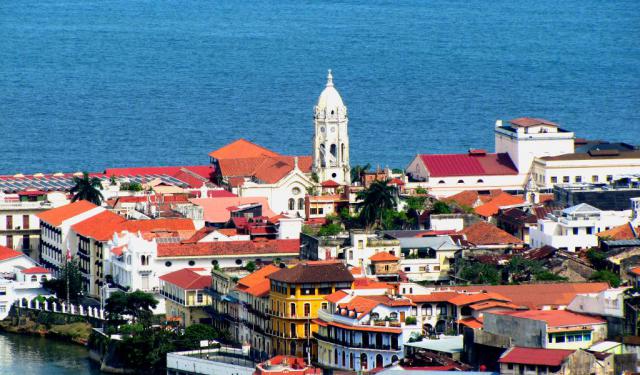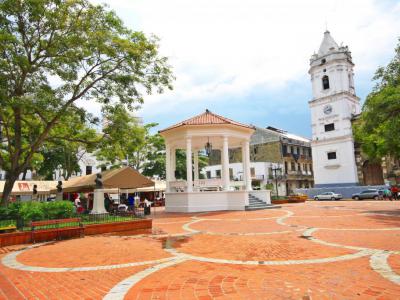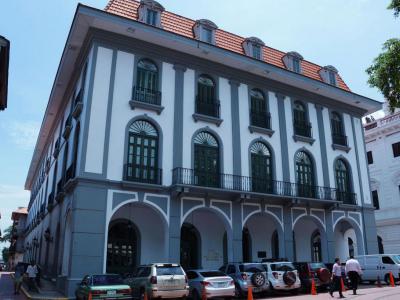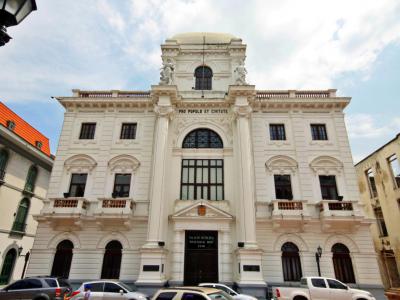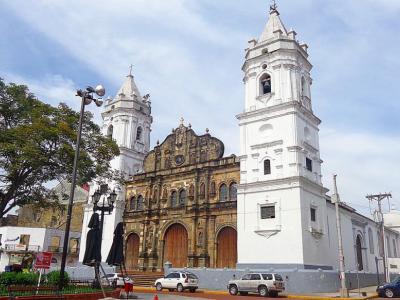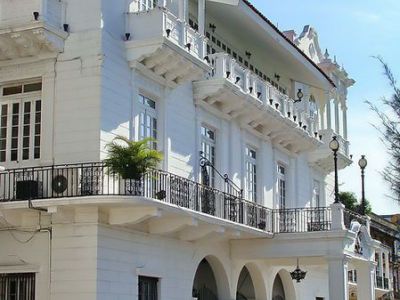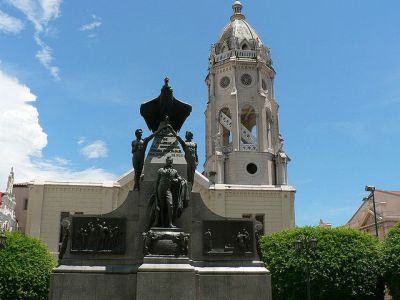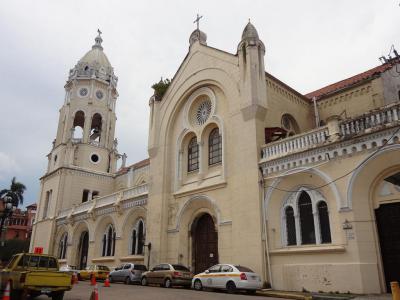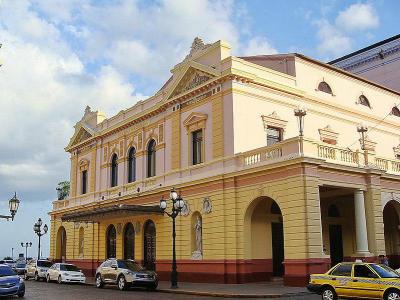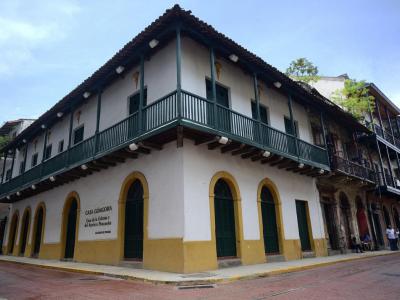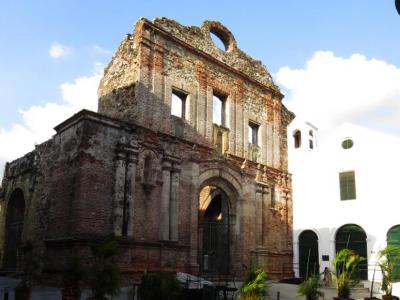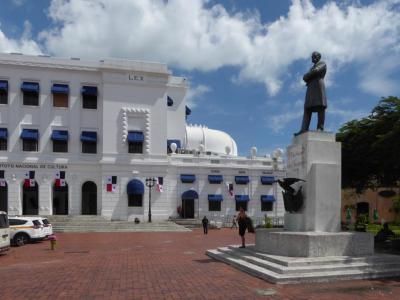Old Town Walking Tour (Self Guided), Panama City
Casco Antiguo, also known as Casco Viejo, is the fabulous old city of Panama. UNESCO has recognized the old city's cultural and architectural importance and listed Old Town as a World Heritage Site.
Spain founded Panama City in 1519. In 1671, pirate Henry Morgan destroyed the original city. In 1674 Spanish conquistador Alonso Mercado de Villacorta rebuilt Casco Viejo five miles south of its original location. In 1751 the area became part of the Viceroyalty of New Granada and later joined with Columbia.
Panama became an independent nation in 1903, and Panama City became the nation's capital. American engineers constructed the Panama Canal between 1904-1914. The canal changed Panama into a vital worldwide shipping link, and thousands of ships continue to use the canal that links the Atlantic and Pacific oceans.
In this walking tour, stand in Independence Square and celebrate Panama's independence. Admire several historical churches. In the Metropolitan Cathedral, see the impressive marble altar blessed by Pope Francis. The Church of Saint Francis of Assisi features eight hardwood baroque altars.
Visitors will be fascinated by one of the oldest colonial homes in Old Town, Casa Gongora. This home was built in 1756 by a Spanish pearl merchant. Today, this historic house is open to the public.
Visitors will also find several fascinating museums on this route. At the Panama Canal Museum, learn about the workers from 192 countries who labored on the Panama Canal. The Panama History Museum covers the important time frames of life in Panama, from the 1500s to the present. The Museum of Colonial Religious Art has religious artifacts dating back to the 16th century.
Take this self-guided tour to explore the most notable sights of Old Town.
Spain founded Panama City in 1519. In 1671, pirate Henry Morgan destroyed the original city. In 1674 Spanish conquistador Alonso Mercado de Villacorta rebuilt Casco Viejo five miles south of its original location. In 1751 the area became part of the Viceroyalty of New Granada and later joined with Columbia.
Panama became an independent nation in 1903, and Panama City became the nation's capital. American engineers constructed the Panama Canal between 1904-1914. The canal changed Panama into a vital worldwide shipping link, and thousands of ships continue to use the canal that links the Atlantic and Pacific oceans.
In this walking tour, stand in Independence Square and celebrate Panama's independence. Admire several historical churches. In the Metropolitan Cathedral, see the impressive marble altar blessed by Pope Francis. The Church of Saint Francis of Assisi features eight hardwood baroque altars.
Visitors will be fascinated by one of the oldest colonial homes in Old Town, Casa Gongora. This home was built in 1756 by a Spanish pearl merchant. Today, this historic house is open to the public.
Visitors will also find several fascinating museums on this route. At the Panama Canal Museum, learn about the workers from 192 countries who labored on the Panama Canal. The Panama History Museum covers the important time frames of life in Panama, from the 1500s to the present. The Museum of Colonial Religious Art has religious artifacts dating back to the 16th century.
Take this self-guided tour to explore the most notable sights of Old Town.
How it works: Download the app "GPSmyCity: Walks in 1K+ Cities" from Apple App Store or Google Play Store to your mobile phone or tablet. The app turns your mobile device into a personal tour guide and its built-in GPS navigation functions guide you from one tour stop to next. The app works offline, so no data plan is needed when traveling abroad.
Old Town Walking Tour Map
Guide Name: Old Town Walking Tour
Guide Location: Panama » Panama City (See other walking tours in Panama City)
Guide Type: Self-guided Walking Tour (Sightseeing)
# of Attractions: 11
Tour Duration: 1 Hour(s)
Travel Distance: 0.9 Km or 0.6 Miles
Author: DanaOffice
Sight(s) Featured in This Guide:
Guide Location: Panama » Panama City (See other walking tours in Panama City)
Guide Type: Self-guided Walking Tour (Sightseeing)
# of Attractions: 11
Tour Duration: 1 Hour(s)
Travel Distance: 0.9 Km or 0.6 Miles
Author: DanaOffice
Sight(s) Featured in This Guide:
- Plaza de la Independencia (Independence Square)
- Panama Canal Museum
- Panama History Museum
- Metropolitan Cathedral
- Herons' Palace (Presidential Palace)
- Parque Bolivar (Bolivar Park)
- Church of Saint Francis of Assisi
- Teatro Nacional (National Theater)
- Casa Gongora (Gongora House)
- Museum of Colonial Religious Art
- Plaza de Francia (France Square)
1) Plaza de la Independencia (Independence Square)
Panama declared its independence from Colombia on November 3, 1903 in Plaza de la Independencia. This historic site is also known as Plaza Mayor or Cathedral Plaza. As you walk through the plaza, you'll find restaurants, shops, and varied artisan stalls.
The Metropolitan Cathedral of Panama dominates the square. Construction on the cathedral began in 1688 but was not completed until 108 years later, in 1796. The Metropolitan Cathedral of Panama is an excellent example of colonial architecture. Statues of the 12 apostles of Christ adorn the exterior facade.
Visitors will also notice a statue of Santa Maria La Antigua, the patroness of Panama. Two bright white bell towers stand on either side of the historic centerpiece, which features original stones. Inside the church, visitors will find a remarkable altar carved from a single block of Italian marble. Pope Francis blessed this altar in 2019. Take time to admire the beautiful stained glass windows.
The Metropolitan Cathedral of Panama dominates the square. Construction on the cathedral began in 1688 but was not completed until 108 years later, in 1796. The Metropolitan Cathedral of Panama is an excellent example of colonial architecture. Statues of the 12 apostles of Christ adorn the exterior facade.
Visitors will also notice a statue of Santa Maria La Antigua, the patroness of Panama. Two bright white bell towers stand on either side of the historic centerpiece, which features original stones. Inside the church, visitors will find a remarkable altar carved from a single block of Italian marble. Pope Francis blessed this altar in 2019. Take time to admire the beautiful stained glass windows.
2) Panama Canal Museum (must see)
The Panama Canal Museum documents the building of the Panama Canal. Visitors will find exhibits that chronicle the entire process, from before work began, to its transfer from American control to the Panamanian government.
The building that houses the Panama Canal Museum is also historically significant. It was built in 1874 and served as the original headquarters of the French Canal Company. The building was later used as the headquarters of the United States Isthmian Canal Commission. In 1912, the building was used as Panama City's main post office.
The museum has several levels with fascinating exhibits, plans, photos, and artifacts.
Countries across the world were long interested in building a canal that would shorten shipping times and increase safety. However, the financial costs, engineering feats required, and staggering deaths due to yellow fever and malaria significantly hindered the canal's development.
Visitors will learn about the first French attempt at building a canal, which was abandoned after skyrocketing costs and 20,000 deaths. Next, visitors will learn about American involvement in creating the canal that exists today.
The Panama Canal Museum has many exhibits focusing on the day-to-day lives of the canal workers, who came from 97 countries.
The lobby features a massive original Fresnel lens used in one of the now decommissioned lighthouses along the canal.
Why You Should Visit:
The Panama Canal is one of the most fascinating feats of engineering and perseverance in the modern world. The Panama Canal Museum lays out the story of its creation while recognizing the challenges and hardships faced by the workers.
Tips:
The exhibits feature a lot of information in Spanish. You can pay for an English language audio tour to save some effort in translation.
The building that houses the Panama Canal Museum is also historically significant. It was built in 1874 and served as the original headquarters of the French Canal Company. The building was later used as the headquarters of the United States Isthmian Canal Commission. In 1912, the building was used as Panama City's main post office.
The museum has several levels with fascinating exhibits, plans, photos, and artifacts.
Countries across the world were long interested in building a canal that would shorten shipping times and increase safety. However, the financial costs, engineering feats required, and staggering deaths due to yellow fever and malaria significantly hindered the canal's development.
Visitors will learn about the first French attempt at building a canal, which was abandoned after skyrocketing costs and 20,000 deaths. Next, visitors will learn about American involvement in creating the canal that exists today.
The Panama Canal Museum has many exhibits focusing on the day-to-day lives of the canal workers, who came from 97 countries.
The lobby features a massive original Fresnel lens used in one of the now decommissioned lighthouses along the canal.
Why You Should Visit:
The Panama Canal is one of the most fascinating feats of engineering and perseverance in the modern world. The Panama Canal Museum lays out the story of its creation while recognizing the challenges and hardships faced by the workers.
Tips:
The exhibits feature a lot of information in Spanish. You can pay for an English language audio tour to save some effort in translation.
3) Panama History Museum
The Panama History Museum is located on the ground floor of the Municipal Palace of Panama City. This neoclassical-style building was constructed in 1910.
The museum covers all facets of Panama's history, with displays divided across three exhibit rooms. The Colonial History Room covers the Colonial Period from 1501 to 1821. Here, visitors will find route maps, original European and Indigenous weapons, and copies of old engravings.
You'll find information about the Union to Columbia in the Departmental History Room, from 1821 to 1903. Copies of old photographs illustrate this time period.
The Republican History room celebrates the Republican Period from 1903 to the present. Features include a replica of the first Panamanian flag, designed by the first President's spouse, María Ossa de Amador. The original design of the Panamanian Coat of Arms is also on display. Visitors can view a draft of a telegram dated November 3, 1903, the date that Panama became independent.
The museum covers all facets of Panama's history, with displays divided across three exhibit rooms. The Colonial History Room covers the Colonial Period from 1501 to 1821. Here, visitors will find route maps, original European and Indigenous weapons, and copies of old engravings.
You'll find information about the Union to Columbia in the Departmental History Room, from 1821 to 1903. Copies of old photographs illustrate this time period.
The Republican History room celebrates the Republican Period from 1903 to the present. Features include a replica of the first Panamanian flag, designed by the first President's spouse, María Ossa de Amador. The original design of the Panamanian Coat of Arms is also on display. Visitors can view a draft of a telegram dated November 3, 1903, the date that Panama became independent.
4) Metropolitan Cathedral
No trip to Panama City's Old Town is complete without visiting a beautiful historic edifice on Independence Square, that is Metropolitan Cathedral. The construction of the cathedral started in 1688 and took 108 years to complete, so the place was not officially consecrated until 1796. In the late 19th century, an earthquake destroyed pretty much all of the neighboring buildings, but the cathedral itself remarkably survived. Also surprisingly, for many years later it had remained deserted until a major renovation was undertaken in 2003.
The cathedral stands out for its contrasting color combination and the mix of architectural styles which in turn offers a glimpse of the fascinating history of the country. The stones used for the construction of the entrance wall were taken from the ruins of the city of Viejo. Grey in color, this wall is contrasted by the two tower-like structures on both sides of the entrance, which are white. These towers are layered with material called “mother of pearl”, brought from the Pearl Islands.
The cathedral is particularly spectacular at night when the whole structure is lit up.
The cathedral stands out for its contrasting color combination and the mix of architectural styles which in turn offers a glimpse of the fascinating history of the country. The stones used for the construction of the entrance wall were taken from the ruins of the city of Viejo. Grey in color, this wall is contrasted by the two tower-like structures on both sides of the entrance, which are white. These towers are layered with material called “mother of pearl”, brought from the Pearl Islands.
The cathedral is particularly spectacular at night when the whole structure is lit up.
5) Herons' Palace (Presidential Palace)
This official presidential residence was originally constructed by the Spanish in the 17th century and is a beautiful example of Spanish colonial architecture. Initially this pristine white building, decorated in true Moorish style, was used as a customs house.
You can see the spacious inner courtyard along with the airy lobby designed in a way to emulate Andalusian style. Ornately decorated fountains adorn the courtyard. However, it is not the white color or the décor that earn the building its sobriquet, but the white African herons that are found strolling freely in the palace. The herons were brought here after the completion of the final renovations that were carried out under the then president, Belisario Porras.
An elevator was added in 1934 for a state visit by U.S. President Franklin Roosevelt so that he could access the chambers where he was to stay. Rumors have it that during the visit of the U.S. president Richard Nixon in 1977, the palace was sprayed with disinfectant that caused the death of all herons there. The dead herons were said to be replaced overnight.
The palace lies in the center of the old quarter of Panama City. Though an entry to the palace is restricted, you can easily liaise with a friendly guard and take a quick peek and maybe click a few snaps too.
You can see the spacious inner courtyard along with the airy lobby designed in a way to emulate Andalusian style. Ornately decorated fountains adorn the courtyard. However, it is not the white color or the décor that earn the building its sobriquet, but the white African herons that are found strolling freely in the palace. The herons were brought here after the completion of the final renovations that were carried out under the then president, Belisario Porras.
An elevator was added in 1934 for a state visit by U.S. President Franklin Roosevelt so that he could access the chambers where he was to stay. Rumors have it that during the visit of the U.S. president Richard Nixon in 1977, the palace was sprayed with disinfectant that caused the death of all herons there. The dead herons were said to be replaced overnight.
The palace lies in the center of the old quarter of Panama City. Though an entry to the palace is restricted, you can easily liaise with a friendly guard and take a quick peek and maybe click a few snaps too.
6) Parque Bolivar (Bolivar Park)
Simón Bolívar is respected as a Latin American hero. In 1826, in a schoolroom across the street from Parque Bolivar, Bolivar held a pivotal meeting. The Venezuelan general urged that Latin American countries break free from Spanish rule and form their own state, Gran Columbia. While the original proposal failed, General Bolivar succeeded in liberating Bolivia, Panama, Columbia, Ecuador, Peru, and Venezuela from Spanish rule.
After a fire destroyed houses in this location, the empty lot was named Bolívar Plaza in 1883.
In 1926, a monument was unveiled to celebrate the 100th anniversary of Bolívar's Amphictyonic Congress. The monument captures Bolívar's life using decorative friezes. An Andean condor is represented above the monument.
This park is a central part of daily life in Panama City. Kids play in the shade of the mango and palm trees in the day while adults chat on park benches.
After a fire destroyed houses in this location, the empty lot was named Bolívar Plaza in 1883.
In 1926, a monument was unveiled to celebrate the 100th anniversary of Bolívar's Amphictyonic Congress. The monument captures Bolívar's life using decorative friezes. An Andean condor is represented above the monument.
This park is a central part of daily life in Panama City. Kids play in the shade of the mango and palm trees in the day while adults chat on park benches.
7) Church of Saint Francis of Assisi
Church of Saint Francis of Assisi is a Roman Catholic Church in the historic district of Casco Viejo. This church is very popular for its magnificent view, making it a very popular tourist spot in Panama City. The church is small compared to the other churches but you will be dazed by its splendor as it is one of the most beautiful local churches.
Located on the ground of Bolivar Park, the Church of Saint Francis of Assisi was repeatedly destroyed by fire in 1737 and 1756. It was fully rebuilt in 1998. The church lies across the street from the National Theater. Down the street, just a block away, is the residence of Panamanian President, the Herons' Palace.
The Church of Saint Francis of Assisi was built of a stout stone structure way back in the early 1700s. Indigenous artisans from the nearby town of San Francisco, supervised by Franciscan monks, helped to build the eight hardwood baroque altars. The elegant main altar consists of over 400 pieces of colorfully painted tropical cedar and is an impressive example of colonial art. All in all, this historical church is well worth a visit.
Located on the ground of Bolivar Park, the Church of Saint Francis of Assisi was repeatedly destroyed by fire in 1737 and 1756. It was fully rebuilt in 1998. The church lies across the street from the National Theater. Down the street, just a block away, is the residence of Panamanian President, the Herons' Palace.
The Church of Saint Francis of Assisi was built of a stout stone structure way back in the early 1700s. Indigenous artisans from the nearby town of San Francisco, supervised by Franciscan monks, helped to build the eight hardwood baroque altars. The elegant main altar consists of over 400 pieces of colorfully painted tropical cedar and is an impressive example of colonial art. All in all, this historical church is well worth a visit.
8) Teatro Nacional (National Theater)
The National Theater of Panama is located on Avenida B, just down from Plaza Bolivar. It opened in 1908 and was constructed on the site that originally housed an 18th century monastery. Throughout its history, the building has seen good and bad days during which, at some point, it served as a house for movies and a popular watering hole for the elite crowd.
The theater has endured a profound restoration undertaken in two phases: first in the 1970s and the second, more recently, in the early 2000s, upon which it finally reopened in 2004. Adorned with glittering glass chandeliers, gold painted balconies and exquisite ceiling murals, the interiors of the building are truly posh. Busts of famous writers are placed upfront. The theater is a major cultural hub that hosts cultural events like plays, operas and ballets.
The ceiling frescoes have been painted by a prominent Panamanian artist, Roberto Lewis, and depict Panamanian history in the form of Greek mythology. You can go for an opera show whenever you get the opportunity, whilst in the city. This is really the best way to check out the building.
The theater has endured a profound restoration undertaken in two phases: first in the 1970s and the second, more recently, in the early 2000s, upon which it finally reopened in 2004. Adorned with glittering glass chandeliers, gold painted balconies and exquisite ceiling murals, the interiors of the building are truly posh. Busts of famous writers are placed upfront. The theater is a major cultural hub that hosts cultural events like plays, operas and ballets.
The ceiling frescoes have been painted by a prominent Panamanian artist, Roberto Lewis, and depict Panamanian history in the form of Greek mythology. You can go for an opera show whenever you get the opportunity, whilst in the city. This is really the best way to check out the building.
9) Casa Gongora (Gongora House)
Gongora House is one of the oldest and the only genuine colonial house in Panama City. Built in 1756 by Captain Paul Gongora, a Spanish merchant who dealt in pearls, this is the last surviving piece of the 18th century colonial architecture in the city. The house was bequeathed to the church after Gongora's death and changed hands several times before it was finally handed over to the Panama Municipality in 1995.
UNESCO declared Gongora House along with the entire Old Town as the World Heritage site in 1997. During restoration that took place in 1998-99, much of the original woodwork, such as the doors, balconies and the armor, were left intact. Now a municipal property, Gongora House serves as a cultural center and hosts regular exhibitions by local artists. You can pop in casually to see some local creations or just admire the restored architecture and woodwork. You can also attend free jazz concerts on Wednesday nights at 8 o'clock and, if lucky, get a chance to catch Friday night bolero concert as well.
A legacy of the colonial rule, Gongora House is known to be of a great historic importance for having retained its original architectural style until today. Touring this extraordinary place will give you an opportunity to see with your own eyes what life was like in the colonial times. The house is open on all days and the entry is free.
UNESCO declared Gongora House along with the entire Old Town as the World Heritage site in 1997. During restoration that took place in 1998-99, much of the original woodwork, such as the doors, balconies and the armor, were left intact. Now a municipal property, Gongora House serves as a cultural center and hosts regular exhibitions by local artists. You can pop in casually to see some local creations or just admire the restored architecture and woodwork. You can also attend free jazz concerts on Wednesday nights at 8 o'clock and, if lucky, get a chance to catch Friday night bolero concert as well.
A legacy of the colonial rule, Gongora House is known to be of a great historic importance for having retained its original architectural style until today. Touring this extraordinary place will give you an opportunity to see with your own eyes what life was like in the colonial times. The house is open on all days and the entry is free.
10) Museum of Colonial Religious Art
The Museum of Colonial Religious Art is housed in the restored Church and Convent of Santo Domingo that was built in 1673. The original structure was ravaged by fire in 1737 and 1756 along with much of Panama City.
Today, you can see a beautiful building with columns and bricks paired inlaid facades. The prominent, flat 15-meter long Arco Chato is a famous arch that used to form the choir base in the original building and is still in place. During the long debate in the US congress over the proposed location of the then nascent canal across the American continent, the Arco Chato is said to have tipped the scales in Panama’s favor since its survival was taken as the proof that that the area was not in an earthquake zone.
The museum collection includes colonial era religious artifacts dating back to the 16th century. If you have a penchant for museums or want to explore religious art, this would be a good place to visit.
Today, you can see a beautiful building with columns and bricks paired inlaid facades. The prominent, flat 15-meter long Arco Chato is a famous arch that used to form the choir base in the original building and is still in place. During the long debate in the US congress over the proposed location of the then nascent canal across the American continent, the Arco Chato is said to have tipped the scales in Panama’s favor since its survival was taken as the proof that that the area was not in an earthquake zone.
The museum collection includes colonial era religious artifacts dating back to the 16th century. If you have a penchant for museums or want to explore religious art, this would be a good place to visit.
11) Plaza de Francia (France Square)
France Square is located at the southern point of the city and showcases statues and large stone tablets narrating the story of French role in the construction of the Panama Canal. The square is dedicated to the memory of the approximately 22,000 workers hailed from France, Martinique and Guadeloupe, who passed away whilst attempting to build the canal. The majority of them died of diseases such as yellow fever and malaria.
You will also see the monument which was built in remembrance of the Cuban doctor Carlos J. Finlay, who found out how the mosquitoes transmitted yellow fever. His excellent work and dedication led to the eradication of the disease in the city and eventually around the world.
On the one side of the square you will see the restored dungeons nine of which were used by the Spaniards and subsequently by the Colombians - Paseo de Las Bovedas. These arched 18th-century vaults were used for prisoners & storage. Even though nowadays some of them house restaurants and upscale art galleries, the original stonework of the dungeons is still in place.
One such restaurant - Las Bovedas, is a fashionable and popular club. It attracts guests who love jazz and spending a romantic evening enjoying delicious cocktails. A visit to France Square will definitely enrich your experience in Panama City.
You will also see the monument which was built in remembrance of the Cuban doctor Carlos J. Finlay, who found out how the mosquitoes transmitted yellow fever. His excellent work and dedication led to the eradication of the disease in the city and eventually around the world.
On the one side of the square you will see the restored dungeons nine of which were used by the Spaniards and subsequently by the Colombians - Paseo de Las Bovedas. These arched 18th-century vaults were used for prisoners & storage. Even though nowadays some of them house restaurants and upscale art galleries, the original stonework of the dungeons is still in place.
One such restaurant - Las Bovedas, is a fashionable and popular club. It attracts guests who love jazz and spending a romantic evening enjoying delicious cocktails. A visit to France Square will definitely enrich your experience in Panama City.
Walking Tours in Panama City, Panama
Create Your Own Walk in Panama City
Creating your own self-guided walk in Panama City is easy and fun. Choose the city attractions that you want to see and a walk route map will be created just for you. You can even set your hotel as the start point of the walk.
Historical Churches Tour
Caught between the lush green mountains and the ocean, the capital of Panama is a concentration of colors and styles. The evidence of Spanish influence is still vivid in the colonial landmarks, especially religious sites.
For centuries, colonial religious architecture has played an important role in the configuration of the urban layout of Panama City. By the 17th century, convents had an... view more
Tour Duration: 1 Hour(s)
Travel Distance: 1.0 Km or 0.6 Miles
For centuries, colonial religious architecture has played an important role in the configuration of the urban layout of Panama City. By the 17th century, convents had an... view more
Tour Duration: 1 Hour(s)
Travel Distance: 1.0 Km or 0.6 Miles
The Most Popular Cities
/ view all
